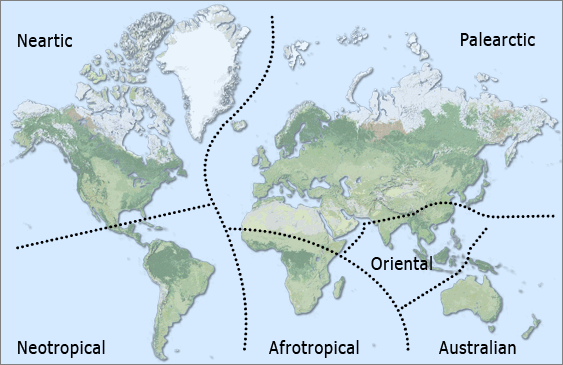Last updated on February 16th, 2020
Chrysidids are distributed in all the zoogeographic Regions, except for the Antarctica. Cleptids of the genus Cleptes are perhaps the most primitive and ancient group among chrysididae, because of their hosts diets (they parasite primitive wasps like Sawflies, linked to plants of the temperate climates). Those species are nearly exclusive of the northern hemisphere (Holarctic Region), absent – or nearly – from the tropical regions. Also the Amiseginae seem to have developed in the northern hemisphere and then migrated to the Oriental and to the Neotropical Regions during the Quaternary and extincted elsewhere perhaps during the glaciations. Same thing for the Chrysidinae, currently dominant in the Palearctic and in the Neotropical Regions. The Chrysidinae of the other Regions are derived in subsequent successive times.
The chrysidid fauna of the Australian Region is considerably poorer than that of the other Regions and shows in-common taxa with the Oriental fauna. It is reasonable that Chrysidids have seen a remarkable evolutionary differentiation, as testified by the absence of affinity between the faunas of the regions splitted off from the “One Continent” (Gondwana) and by the endemism of many Genera.
The human activity is responsible of the current wide distribution for some species, through the exchange of vegetals hosting larvas and adults: wood, plants, canes, etc. Some examples of widespread species: Stilbum cyanurum, Omalus aeneus, Pseudomalus auratus.
| Palearctic | Afrotropical | Oriental | Australian | Nearctic | Neotropical |
|---|---|---|---|---|---|
| Cleptinae | – | Cleptinae | – | Cleptinae | Cleptinae |
| – | Amiseginae | Amiseginae | Amiseginae | Amiseginae | Amiseginae |
| – | – | Loboscelidiinae | Loboscelidiinae | – | – |
| – | Allocoeliini | – | – | – | – |
| Elampini | Elampini | Elampini | Elampini | Elampini | Elampini |
| Chrysidini | Chrysidini | Chrysidini | Chrysidini | Chrysidini | Chrysidini |
| Parnopini | Parnopini | – | – | Parnopini | – |

Copyright, Authorship, and Ownership statements
All text and images of this page are copyright ©️ Chrysis.net unless otherwise stated - please see individual cases for authorship and copyright details. The specimens pictured are from the authors' or other collaborators' personal collections and from the collections of various museums. Unless otherwise specified, the whole content of this web site is for personal, non-commercial, scientific, and educational purposes given proper accreditation to the page from which they were derived are provided, and under Chrysis.net Terms and Conditions.
For citation purposes
Agnoli G.L. & Rosa P. (2025) Biogeography of Chrysididae, in: Chrysis.net website. Interim version 31 March 2025, URL: https://www.chrysis.net/chrysididae/biogeography-of-chrysididae/.




